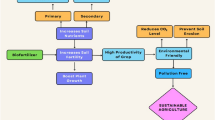Abstract
The role of blue-green algae (BGA) and Azolla in supplying N to rice fields is well documented. In addition, they also bring about, directly or indirectly, a number of changes in the physical, chemical and biological properties of the soil and soil-water interface in rice fields. For example, BGA liberate extracellular organic compounds and photosynthetic O2 during their growth, while Azolla prevent a rise in the pH, reduce water temperature, curb NH3 volatilisation and suppress weeds; and both of them contribute biomass. On decomposing, they influence the redox activity and result in the formation of different organic acids in soil. All such changes brought about by BGA and Azolla in soil may ultimately influence plant-available nutrients and also soil characteristics. An attempt has been made in this review to highlight these effects of BGA and Azolla in rice fields and discuss their possible implications relating to management and productivity of rice-field systems.
Similar content being viewed by others
Author information
Authors and Affiliations
Additional information
Received: 4 February 1998
Rights and permissions
About this article
Cite this article
Mandal, B., Vlek, P. & Mandal, L. Beneficial effects of blue-green algae and Azolla, excluding supplying nitrogen, on wetland rice fields: a review. Biol Fertil Soils 28, 329–342 (1999). https://doi.org/10.1007/s003740050501
Issue Date:
DOI: https://doi.org/10.1007/s003740050501




